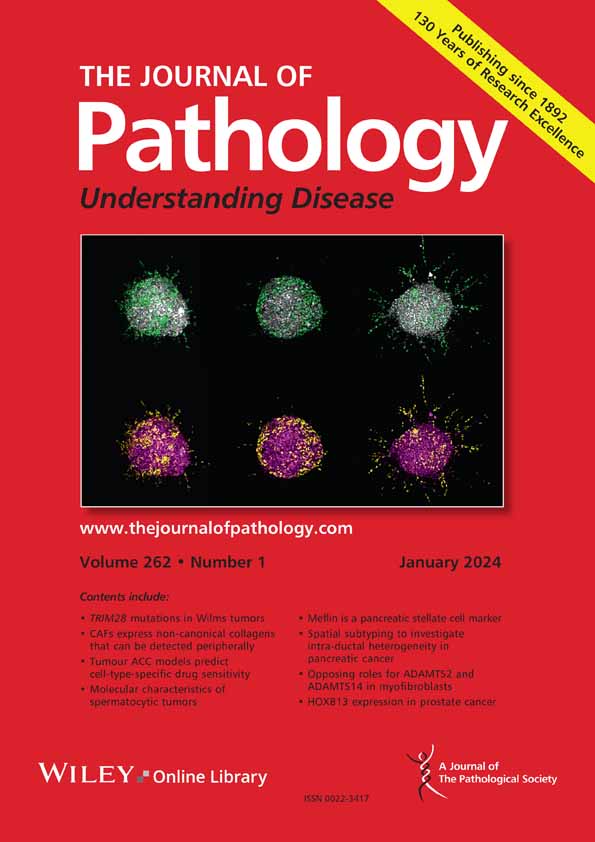Feng Xu, Lei Li, Shuyang Wang, Ren Ling, Xie Zhang, Xi Deng, Mengzhe Zhou, Jin Ling, Chaofei Gao
求助PDF
{"title":"基于层次特征集成和局部图像模式的超分辨率病理图像。","authors":"Feng Xu, Lei Li, Shuyang Wang, Ren Ling, Xie Zhang, Xi Deng, Mengzhe Zhou, Jin Ling, Chaofei Gao","doi":"10.1002/path.6482","DOIUrl":null,"url":null,"abstract":"<p><p>Recent advancements in pathological imaging have facilitated single-cell and subcellular-level analysis based on high-resolution images for tumor subtyping, cytomorphological assessment, and infection detection. As high-resolution imaging is often limited by cost, super-resolution methods provide a practical alternative with only low-resolution data. However, existing methods generally suffer from artifacts, oversmoothing, and slow inference speed. In this study, we developed a hierarchal deep learning framework based on local pathological image patterns, named Hierarchical Local Image Patterns (HLIP), to achieve accurate, high-fidelity, and real-time super resolution with flexible magnifications. HLIP integrates semantic features with both pixel- and morphology-level features and reconstructs super-resolution images by the recognized local pathological image patterns. Benchmark analysis showed HLIP achieved the best performance and robustness on both internal and external test datasets. The generated super-resolution images contain abundant pathological details and maintain high fidelity. HLIP can be used for the enhancement of other models across multiple clinical scenarios, including gland segmentation, cell segmentation, Helicobacter pylori detection, and therapy response prediction. With its superior performance in pathology image super resolution, HLIP offers a versatile tool for image preprocessing in computer-aided systems, thereby supporting accurate diagnosis in clinical practice. © 2025 The Pathological Society of Great Britain and Ireland.</p>","PeriodicalId":232,"journal":{"name":"The Journal of Pathology","volume":" ","pages":""},"PeriodicalIF":5.2000,"publicationDate":"2025-10-13","publicationTypes":"Journal Article","fieldsOfStudy":null,"isOpenAccess":false,"openAccessPdf":"","citationCount":"0","resultStr":"{\"title\":\"Super resolution of pathology images with hierarchical feature integration and local image patterns.\",\"authors\":\"Feng Xu, Lei Li, Shuyang Wang, Ren Ling, Xie Zhang, Xi Deng, Mengzhe Zhou, Jin Ling, Chaofei Gao\",\"doi\":\"10.1002/path.6482\",\"DOIUrl\":null,\"url\":null,\"abstract\":\"<p><p>Recent advancements in pathological imaging have facilitated single-cell and subcellular-level analysis based on high-resolution images for tumor subtyping, cytomorphological assessment, and infection detection. As high-resolution imaging is often limited by cost, super-resolution methods provide a practical alternative with only low-resolution data. However, existing methods generally suffer from artifacts, oversmoothing, and slow inference speed. In this study, we developed a hierarchal deep learning framework based on local pathological image patterns, named Hierarchical Local Image Patterns (HLIP), to achieve accurate, high-fidelity, and real-time super resolution with flexible magnifications. HLIP integrates semantic features with both pixel- and morphology-level features and reconstructs super-resolution images by the recognized local pathological image patterns. Benchmark analysis showed HLIP achieved the best performance and robustness on both internal and external test datasets. The generated super-resolution images contain abundant pathological details and maintain high fidelity. HLIP can be used for the enhancement of other models across multiple clinical scenarios, including gland segmentation, cell segmentation, Helicobacter pylori detection, and therapy response prediction. With its superior performance in pathology image super resolution, HLIP offers a versatile tool for image preprocessing in computer-aided systems, thereby supporting accurate diagnosis in clinical practice. © 2025 The Pathological Society of Great Britain and Ireland.</p>\",\"PeriodicalId\":232,\"journal\":{\"name\":\"The Journal of Pathology\",\"volume\":\" \",\"pages\":\"\"},\"PeriodicalIF\":5.2000,\"publicationDate\":\"2025-10-13\",\"publicationTypes\":\"Journal Article\",\"fieldsOfStudy\":null,\"isOpenAccess\":false,\"openAccessPdf\":\"\",\"citationCount\":\"0\",\"resultStr\":null,\"platform\":\"Semanticscholar\",\"paperid\":null,\"PeriodicalName\":\"The Journal of Pathology\",\"FirstCategoryId\":\"3\",\"ListUrlMain\":\"https://doi.org/10.1002/path.6482\",\"RegionNum\":2,\"RegionCategory\":\"医学\",\"ArticlePicture\":[],\"TitleCN\":null,\"AbstractTextCN\":null,\"PMCID\":null,\"EPubDate\":\"\",\"PubModel\":\"\",\"JCR\":\"Q1\",\"JCRName\":\"ONCOLOGY\",\"Score\":null,\"Total\":0}","platform":"Semanticscholar","paperid":null,"PeriodicalName":"The Journal of Pathology","FirstCategoryId":"3","ListUrlMain":"https://doi.org/10.1002/path.6482","RegionNum":2,"RegionCategory":"医学","ArticlePicture":[],"TitleCN":null,"AbstractTextCN":null,"PMCID":null,"EPubDate":"","PubModel":"","JCR":"Q1","JCRName":"ONCOLOGY","Score":null,"Total":0}
引用次数: 0
引用
批量引用

 求助内容:
求助内容: 应助结果提醒方式:
应助结果提醒方式:


